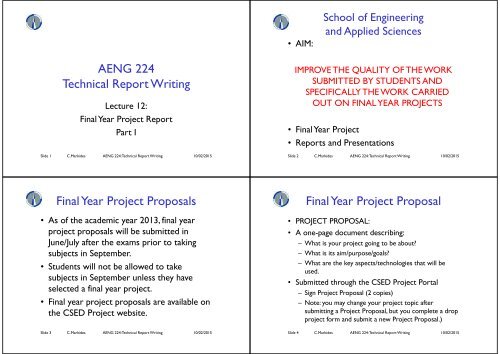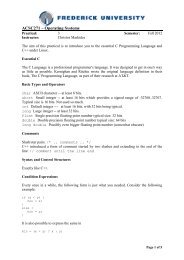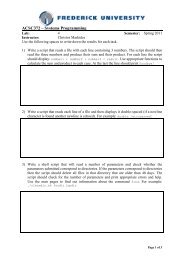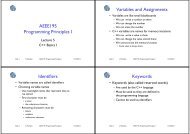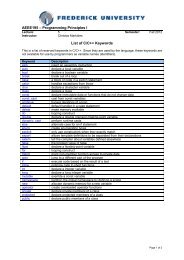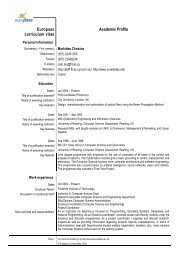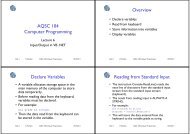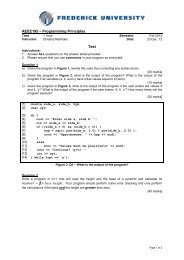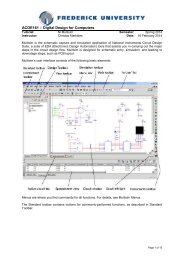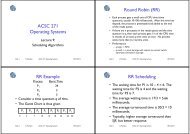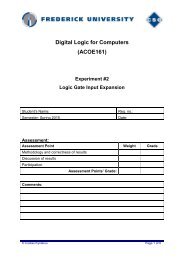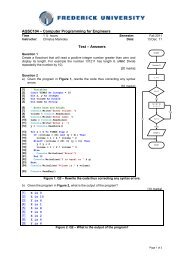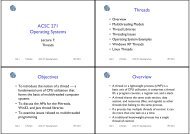AENG 224 Technical Report Writing Final Year Project Proposals ...
AENG 224 Technical Report Writing Final Year Project Proposals ...
AENG 224 Technical Report Writing Final Year Project Proposals ...
Create successful ePaper yourself
Turn your PDF publications into a flip-book with our unique Google optimized e-Paper software.
• AIM:<br />
School of Engineering<br />
and Applied Sciences<br />
<strong>AENG</strong> <strong>224</strong><br />
<strong>Technical</strong> <strong>Report</strong> <strong>Writing</strong><br />
Lecture 12:<br />
<strong>Final</strong> <strong>Year</strong> <strong>Project</strong> <strong>Report</strong><br />
Part I<br />
Slide 1 C.Markides <strong>AENG</strong> <strong>224</strong>: <strong>Technical</strong> <strong>Report</strong> <strong>Writing</strong> 10/02/2015<br />
IMPROVE THE QUALITY OF THE WORK<br />
SUBMITTED BY STUDENTS AND<br />
SPECIFICALLY THE WORK CARRIED<br />
OUT ON FINAL YEAR PROJECTS<br />
• <strong>Final</strong> <strong>Year</strong> <strong>Project</strong><br />
• <strong>Report</strong>s and Presentations<br />
Slide 2 C.Markides <strong>AENG</strong> <strong>224</strong>: <strong>Technical</strong> <strong>Report</strong> <strong>Writing</strong> 10/02/2015<br />
<strong>Final</strong> <strong>Year</strong> <strong>Project</strong> <strong>Proposals</strong><br />
• As of the academic year 2013, final year<br />
project proposals will be submitted in<br />
June/July after the exams prior to taking<br />
subjects in September.<br />
• Students will not be allowed to take<br />
subjects in September unless they have<br />
selected a final year project.<br />
• <strong>Final</strong> year project proposals are available on<br />
the CSED <strong>Project</strong> website.<br />
<strong>Final</strong> <strong>Year</strong> <strong>Project</strong> Proposal<br />
• PROJECT PROPOSAL:<br />
• A one-page document describing:<br />
– What is your project going to be about?<br />
– What is its aim/purpose/goals?<br />
– What are the key aspects/technologies that will be<br />
used.<br />
• Submitted through the CSED <strong>Project</strong> Portal<br />
– Sign <strong>Project</strong> Proposal (2 copies)<br />
– Note: you may change your project topic after<br />
submitting a <strong>Project</strong> Proposal, but you complete a drop<br />
project form and submit a new <strong>Project</strong> Proposal.)<br />
Slide 3 C.Markides <strong>AENG</strong> <strong>224</strong>: <strong>Technical</strong> <strong>Report</strong> <strong>Writing</strong> 10/02/2015<br />
Slide 4 C.Markides <strong>AENG</strong> <strong>224</strong>: <strong>Technical</strong> <strong>Report</strong> <strong>Writing</strong> 10/02/2015
<strong>Final</strong> <strong>Year</strong> <strong>Project</strong> Timeline<br />
• First Semester – 4 ECTS:<br />
– <strong>Project</strong> Proposal<br />
– Initial Work<br />
• SCHEDULE WEEKLY MEETINGS WITH SUPERVISOR<br />
• Getting familiar with your topic<br />
– Keeping in mind what is the aim of your project<br />
– Understanding the aims of your project<br />
• Literature review (library and online)<br />
• READ!!!!!!!!!!!!!!!!!!!!!!!<br />
– Information does not come from the sky<br />
– Ask your supervisor to point you to the right direction<br />
– Preliminary <strong>Report</strong> and Presentation<br />
Preliminary <strong>Report</strong> and Presentation<br />
• A brief report on the work carried out so far on your final year<br />
project.<br />
– Abstract<br />
– Introduction<br />
– Literature review or Research Outline<br />
– Clear analysis and understanding of the goals of the project<br />
– Technologies that will be used indicating why.<br />
– Initial Work<br />
– Organisation of your time (remember this is your final year!)<br />
– Gantt chart (timeline of the work that will be carried out)<br />
– Conclusions<br />
• Presentation<br />
– 7-minute presentation on your project<br />
• Note: If a Preliminary <strong>Report</strong> is not submitted and no<br />
presentation then you have to retake the first part of the<br />
<strong>Final</strong> <strong>Project</strong>.<br />
Slide 5 C.Markides <strong>AENG</strong> <strong>224</strong>: <strong>Technical</strong> <strong>Report</strong> <strong>Writing</strong> 10/02/2015<br />
Slide 6 C.Markides <strong>AENG</strong> <strong>224</strong>: <strong>Technical</strong> <strong>Report</strong> <strong>Writing</strong> 10/02/2015<br />
<strong>Final</strong> <strong>Year</strong> <strong>Project</strong> Timeline<br />
• Second Semester – 5/6 ECTS:<br />
– Continue work<br />
• Backup plan and Fallback position!!<br />
– Complete your project<br />
– Write the report<br />
– Presentation (15-20 minutes)<br />
• Organise your time effectively<br />
– Remember this is your final year<br />
– Start early<br />
– <strong>Project</strong> and subjects (assignments and exams)<br />
• Students that do not complete their final year<br />
project will not be allowed to graduate.<br />
Purpose of the <strong>Report</strong><br />
• Describe your research<br />
– Explain problem or issue studied<br />
– Discuss research method<br />
– Describe data collected<br />
– Describe research findings<br />
– Explain implications<br />
• Inform readers of research results precisely,<br />
concisely, and specifically<br />
– They shouldn’t have to read whole report to<br />
get essential points.<br />
Slide 7 C.Markides <strong>AENG</strong> <strong>224</strong>: <strong>Technical</strong> <strong>Report</strong> <strong>Writing</strong> 10/02/2015<br />
Slide 8 C.Markides <strong>AENG</strong> <strong>224</strong>: <strong>Technical</strong> <strong>Report</strong> <strong>Writing</strong> 10/02/2015
<strong>Report</strong> Planning<br />
• Before writing, consider:<br />
– Why you are writing<br />
– What you hope to achieve<br />
– Who you are writing for<br />
These considerations will determine your<br />
report’s content, organization, textual<br />
and visual design<br />
Essential Sections of a<br />
<strong>Report</strong> or Paper<br />
• Abstract<br />
• Introduction<br />
• Main body<br />
– Analysis<br />
– Design<br />
– Implementation, Testing, Debugging<br />
• Conclusion<br />
• References<br />
Slide 9 C.Markides <strong>AENG</strong> <strong>224</strong>: <strong>Technical</strong> <strong>Report</strong> <strong>Writing</strong> 10/02/2015<br />
Slide 10 C.Markides <strong>AENG</strong> <strong>224</strong>: <strong>Technical</strong> <strong>Report</strong> <strong>Writing</strong> 10/02/2015<br />
<strong>Report</strong> Format and Organization<br />
• <strong>Report</strong>s generally include these sections in this<br />
order:<br />
– Abstract<br />
– Introduction<br />
– Literature Review<br />
• Depending on supervisor and POS (CS or CoE)<br />
– Methodology<br />
• Depending on supervisor and POS (CS or CoE)<br />
– Results<br />
– Conclusions<br />
• In some cases there is chapter on Discussion and another on<br />
Conclusions.<br />
<strong>Report</strong> Format and Organization<br />
• For CS: Instead of Methodology<br />
– Analysis<br />
• Use Software Engineering Principles (theory and tools)<br />
• Use System Analysis (theory and tools)<br />
– Design<br />
• Use Software Engineering Principles<br />
• Use System Analysis (theory and tools)<br />
– Implementation<br />
• Implementation stage DOES NOT LIST CODE ONLY<br />
ALGORITHMS!!!!<br />
• Screenshots of the various screens and explaining the interfacing.<br />
• Explain your interface<br />
• Use Visual Programming and HCI (theory)<br />
– Testing (and Debugging)<br />
• Program Output<br />
Slide 11 C.Markides <strong>AENG</strong> <strong>224</strong>: <strong>Technical</strong> <strong>Report</strong> <strong>Writing</strong> 10/02/2015<br />
Slide 12 C.Markides <strong>AENG</strong> <strong>224</strong>: <strong>Technical</strong> <strong>Report</strong> <strong>Writing</strong> 10/02/2015
<strong>Report</strong> Format and Organization<br />
• For CoE: Instead of Methodology<br />
– Design<br />
• Proposed circuit (advantages disadvantages)<br />
• Design of platforms/controllers/PCB<br />
• Wiring diagrams (gates, states, truth tables, K-maps)<br />
• Components<br />
– Implementation<br />
• Implementation stage<br />
• Breadboard design and fabrication<br />
• Screenshots of the various screens and explaining the<br />
fabrication stages.<br />
• Explain your interface, connections, wiring and ICS<br />
• Programming EEPROMS, SD Cards (i.e. Arduino)<br />
– Testing (and Debugging)<br />
• Program and circuit Output<br />
<strong>Report</strong> Format and Organization<br />
• Conclusions:<br />
– Most students tend to give a one-page descriptive<br />
overview of the work carried out in their project. (Not<br />
Enough!)<br />
– Major findings from your project or research.<br />
– What are the implications of your results?<br />
– Do they confirm or refute others’ observations?<br />
– What are the innovations/contributions/novelties to<br />
your field?<br />
– New hypotheses?<br />
– Proposed future research?<br />
– Practical applications?<br />
Slide 13 C.Markides <strong>AENG</strong> <strong>224</strong>: <strong>Technical</strong> <strong>Report</strong> <strong>Writing</strong> 10/02/2015<br />
Slide 14 C.Markides <strong>AENG</strong> <strong>224</strong>: <strong>Technical</strong> <strong>Report</strong> <strong>Writing</strong> 10/02/2015<br />
Help Material<br />
• HELP/MATERIAL:<br />
– http://staff.fit.ac.cy/CSE<br />
• CSED <strong>Project</strong>s<br />
– http://staff.fit.ac.cy/CSE/projects/<br />
Abstract<br />
• Academic reports and papers always require an<br />
abstract.<br />
• A short précis of your research aimed at enticing<br />
a potential reader.<br />
• The abstract should clearly state what was done,<br />
how it was done, major results and their<br />
significance.<br />
• An abstract should not list the contents of the<br />
report or paper.<br />
• Although the abstract appears at the front of the<br />
report or paper, by its very nature, it must be<br />
written last.<br />
Slide 15 C.Markides <strong>AENG</strong> <strong>224</strong>: <strong>Technical</strong> <strong>Report</strong> <strong>Writing</strong> 10/02/2015<br />
Slide 16 C.Markides <strong>AENG</strong> <strong>224</strong>: <strong>Technical</strong> <strong>Report</strong> <strong>Writing</strong> 10/02/2015
Introduction<br />
• This summarizes the background to, and outlines the<br />
purpose of, the research described.<br />
• It is an extended version of the abstract that clearly states:<br />
– The background of the research including references,<br />
– A clear identification of the problem,<br />
– The proposed solution with a brief outline the methodology<br />
proposed to solve the problem<br />
– A short comment on the results obtained.<br />
– An outline of the content of the report or paper.<br />
• For example:<br />
... in addition to the essential sections of a report or paper,<br />
section 5 emphasizes the need of a structured manuscript.<br />
In section 6, ...<br />
References<br />
• Do not ordinarily copy out standard theory<br />
or other people’s work.<br />
• Refer to it either by number in the text or<br />
author name and date of publication.<br />
• Give the source in a section at the end of<br />
the report or paper.<br />
• Never give references to which you do not<br />
refer in the main body of a report or paper.<br />
Slide 17 C.Markides <strong>AENG</strong> <strong>224</strong>: <strong>Technical</strong> <strong>Report</strong> <strong>Writing</strong> 10/02/2015<br />
Slide 18 C.Markides <strong>AENG</strong> <strong>224</strong>: <strong>Technical</strong> <strong>Report</strong> <strong>Writing</strong> 10/02/2015<br />
Ideas to Write <strong>Report</strong>s<br />
• Design Philosophy: How the job might be<br />
done, with a critical discussion of the<br />
various possibilities, leading up to the one<br />
chosen.<br />
• Results: Whatever they are.<br />
• Discussion: What do the results mean? Are<br />
they self-consistent, and consistent with<br />
theory? Very often results and discussion<br />
form one single section.<br />
Slide 19 C.Markides <strong>AENG</strong> <strong>224</strong>: <strong>Technical</strong> <strong>Report</strong> <strong>Writing</strong> 10/02/2015<br />
Illustrations, Figures,<br />
Tables and equations<br />
• These can appear in the main body of a<br />
technical report or paper.<br />
• Clearly show what you intend them to<br />
show.<br />
• Should be numbered and titled.<br />
• Sufficiently well labeled to be understood<br />
without having to refer back to the text.<br />
• Give all necessary units.<br />
• Avoid pointless repetition.<br />
Slide 20 C.Markides <strong>AENG</strong> <strong>224</strong>: <strong>Technical</strong> <strong>Report</strong> <strong>Writing</strong> 10/02/2015
Equipment and Typing Style<br />
• Laser or Ink Jet Printers, Desk-Top Publishing Equipment<br />
• Font type is Times New Roman (otherwise Bookman or<br />
New Century Schoolbook).<br />
• Use Time New Roman as default type and keep italics<br />
and/or bold for special text parts.<br />
• The font size depends on the type of academic<br />
manuscript.<br />
• Matrix Printers<br />
• The usage of matrix printers is permitted in Near Letter<br />
Quality mode and with a fresh ribbon.<br />
• Do not print in condensed mode.<br />
Abstract<br />
• The abstract should be around 250 words.<br />
• It should be written in italics, using Times New<br />
Roman, size10pt.<br />
• Type the abstract at a maximum width of 140 mm.<br />
• Centre the abstract (horizontally) on the page.<br />
• The abstract is an essential part of the report and<br />
should be type using 10pt font-size.<br />
• Use short, direct, and complete sentences.<br />
• It should be as brief as possible and concise.<br />
• It should be complete, self-explanatory, and not<br />
require reference to the report itself.<br />
Slide 21 C.Markides <strong>AENG</strong> <strong>224</strong>: <strong>Technical</strong> <strong>Report</strong> <strong>Writing</strong> 10/02/2015<br />
Slide 22 C.Markides <strong>AENG</strong> <strong>224</strong>: <strong>Technical</strong> <strong>Report</strong> <strong>Writing</strong> 10/02/2015<br />
Typing Area<br />
• Adjust your page to A4.<br />
• Set the following margins:<br />
– Top: 2.5 cm<br />
– Bottom: 2.5 cm<br />
– Left: 3 cm<br />
– Right: 2.5 cm<br />
• Print on one side of the sheet only.<br />
Typographical Style and Layout<br />
• Title:<br />
– Type the title of your report approx. 2cm<br />
below the first line of the page in Times New<br />
Roman 18 or 20 points, boldface type.<br />
– Centre on the page.<br />
– Use the CSED template.<br />
– Abstract<br />
Slide 23 C.Markides <strong>AENG</strong> <strong>224</strong>: <strong>Technical</strong> <strong>Report</strong> <strong>Writing</strong> 10/02/2015<br />
Slide 24 C.Markides <strong>AENG</strong> <strong>224</strong>: <strong>Technical</strong> <strong>Report</strong> <strong>Writing</strong> 10/02/2015
Headers and Footers<br />
• The recommended font-size is 10 points.<br />
• Top left corner: Title of the report in Times<br />
New Roman, italics.<br />
• Top right corner: Author(s) name(s), Times<br />
New Roman, size 10 pt, italics.<br />
• Bottom right corner: Type Page #, Times<br />
New Roman, 10 pt.<br />
Content List<br />
• This must be provided to guide the reader<br />
through a long technical report in a form<br />
similar to that of the contents list at the<br />
beginning of this document.<br />
• Font size 12 pt, Times New Roman, 2 pt<br />
spacing between lines (double spacing) or<br />
1½ line spacing.<br />
Slide 25 C.Markides <strong>AENG</strong> <strong>224</strong>: <strong>Technical</strong> <strong>Report</strong> <strong>Writing</strong> 10/02/2015<br />
Slide 26 C.Markides <strong>AENG</strong> <strong>224</strong>: <strong>Technical</strong> <strong>Report</strong> <strong>Writing</strong> 10/02/2015<br />
Headings and sub-headings<br />
• Number section and subsection headings consecutively in<br />
Arabic numbers<br />
• Use Bold and Italics respectively using a 12-point font-size.<br />
• Avoid using too many capital letters.<br />
• Keep headings and subheadings aligned left.<br />
• Do not include references to the literature, illustrations or<br />
tables in headings and subheadings.<br />
• Keep two blank lines above a section heading and one<br />
above a subheading.<br />
• Leave one blank line after headings and subheadings.<br />
Main Text<br />
• Type the main text on the full typing width of 160 mm, using the full<br />
length of 247 mm as much as possible.<br />
• The text must be fully justified.<br />
• Type with 2 pts. extra line spacing, if possible. Otherwise, use single<br />
spacing and 12pt-size font.<br />
• Do not use bold in the main text.<br />
• To emphasize specific text use italics, use Time New Roman.<br />
• The first paragraph in each section should not be indented, but all the<br />
following paragraphs within the section should be indented, as these<br />
paragraphs demonstrate.<br />
• Space between paragraphs should be six points.<br />
• The last paragraph of a section does not require additional spacing,<br />
just leave two blank lines before typing the next section heading (or<br />
one blank line if subheading).<br />
Slide 27 C.Markides <strong>AENG</strong> <strong>224</strong>: <strong>Technical</strong> <strong>Report</strong> <strong>Writing</strong> 10/02/2015<br />
Slide 28 C.Markides <strong>AENG</strong> <strong>224</strong>: <strong>Technical</strong> <strong>Report</strong> <strong>Writing</strong> 10/02/2015
Illustrations<br />
Freshman Computer Science - Grade Histogram<br />
Illustrations<br />
14<br />
14<br />
12<br />
12<br />
10<br />
8<br />
6<br />
4<br />
4<br />
6<br />
4 4 4<br />
4<br />
3<br />
7<br />
3<br />
9<br />
9<br />
5<br />
Test 1<br />
Test 2<br />
Exam<br />
<strong>Final</strong><br />
Database<br />
(a)<br />
UML<br />
(b)<br />
2<br />
1<br />
1<br />
2<br />
0<br />
0 0 0<br />
A B C D F<br />
Figure 1. Illustration of a figure than spans the page.<br />
Slide 29 C.Markides <strong>AENG</strong> <strong>224</strong>: <strong>Technical</strong> <strong>Report</strong> <strong>Writing</strong> 10/02/2015<br />
Figure 2. Example of two small figures side by side; (a) Some figure on the left;<br />
(b) some figure on the right<br />
Slide 30 C.Markides <strong>AENG</strong> <strong>224</strong>: <strong>Technical</strong> <strong>Report</strong> <strong>Writing</strong> 10/02/2015<br />
Tables<br />
<strong>Final</strong> <strong>Year</strong> <strong>Project</strong> <strong>Report</strong><br />
• Each <strong>Final</strong> <strong>Year</strong> <strong>Project</strong> is unique<br />
• Work may differ quite significantly from that of another student.<br />
• Supervisors will know what constitutes a good work and how to<br />
write up the work.<br />
• When writing <strong>Final</strong> <strong>Year</strong> <strong>Project</strong> <strong>Report</strong>s:<br />
– The project is intended for the student to develop and demonstrate<br />
– Organisation and extended study<br />
– Demonstrate understanding of appropriate techniques<br />
– Develop skills to produce academic report and communicate orally<br />
(presentation)<br />
– Demonstrate an ordered, critical and reasoned approach to the work the<br />
have achieved.<br />
• The length of the project report should not normally be greater than<br />
5,000 words (from introduction to conclusion).<br />
Slide 31 C.Markides <strong>AENG</strong> <strong>224</strong>: <strong>Technical</strong> <strong>Report</strong> <strong>Writing</strong> 10/02/2015<br />
Slide 32 C.Markides <strong>AENG</strong> <strong>224</strong>: <strong>Technical</strong> <strong>Report</strong> <strong>Writing</strong> 10/02/2015
<strong>Final</strong> <strong>Year</strong> <strong>Project</strong> <strong>Report</strong><br />
• Style guide for technical reports and academic<br />
papers:<br />
– Title page,<br />
– An abstract page,<br />
– An acknowledgement page,<br />
– A content list,<br />
– List of figures and/or table as appropriate, and<br />
– Should be divided in chapters.<br />
• ‘Style Manual for Computer Science And<br />
Engineering <strong>Project</strong> <strong>Report</strong>s’ using the<br />
recommended typographic style and layout given<br />
at the end of this handbook.<br />
Slide 33 C.Markides <strong>AENG</strong> <strong>224</strong>: <strong>Technical</strong> <strong>Report</strong> <strong>Writing</strong> 10/02/2015


